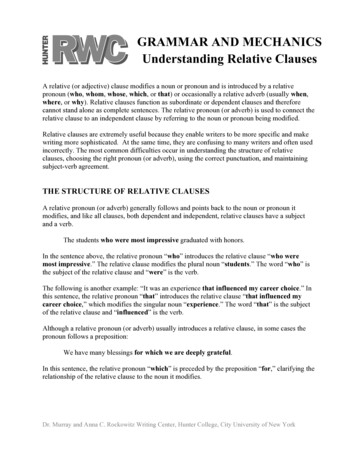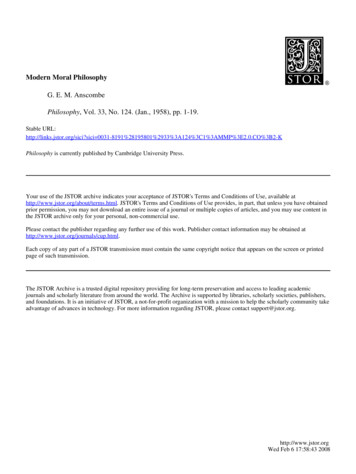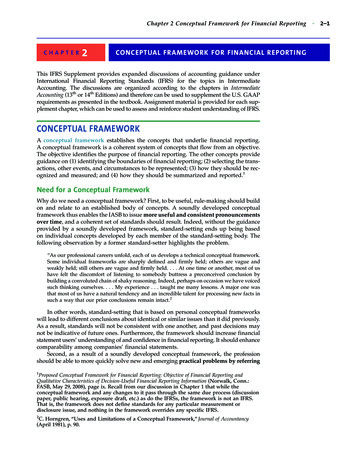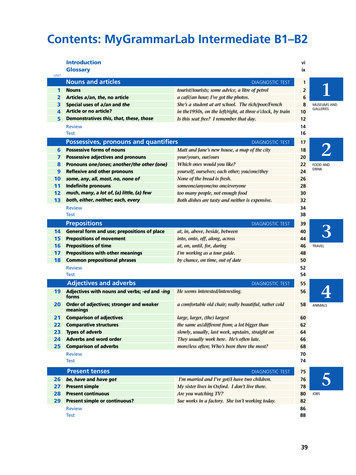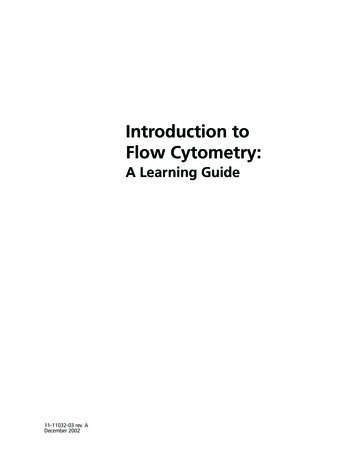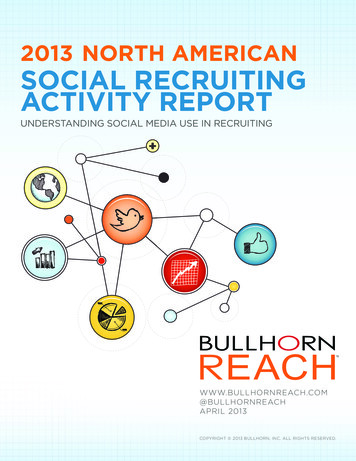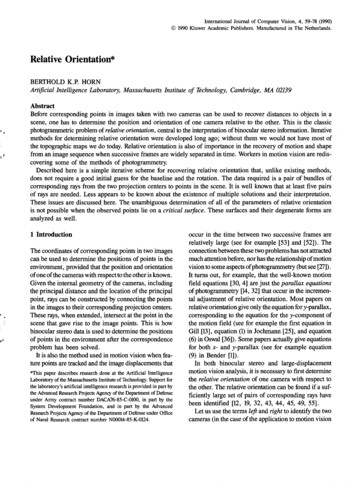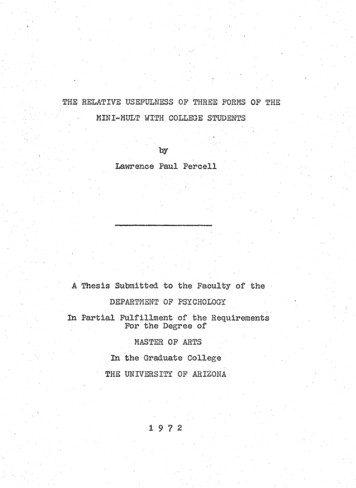
Transcription
THE RELATIVE USEFULNESS OF THREE FORMS OF THEMINI-MULT WITH COLLEGE STUDENTSbyLawrence Paul PercellA Thesis Submitted to the Faculty of theDEPARTMENT OF PSYCHOLOGYIn Partial Fulfillment of the RequirementsFor the Degree ofMASTER OF ARTS.In the Graduate CollegeTHE UNIVERSITY OF ARIZONA19 7 2
STATEMENT BY AUTHORThis thesis has been submitted in partial fulfill ment of requirements for an advanced degree at The Univer sity of Arizona and is deposited in the University Libraryto be made available to borrowers under rules of theLibrary.Brief quotations from this thesis are allowablewithout special permission, provided that accurate acknow ledgment of source is made. Requests for permission forextended quotation from or reproduction of this manuscriptin whole or in part may be granted by the head of the majordepartment or the Dean of the Graduate College when in hisjudgment the proposed use of the material is in the inter ests of scholarship. In all other instances, however,permission must be obtained from the author.SIGNAPPROVAL BY THESIS DIRECTORThis thesis has been approved on the date shown below:-iQdJ?/JOhTTTdELKProfessor of Psychology//7/ J a7A/Date
ACKNOWLEDGMENTSThe author wishes to express his gratitude toDr o' John Lv Delk, his thesis director, for his generousassistance and helpful direction in, the planning and exe cution of the research herein reported0 He also wishes tothank Drsj1 Lewis Hertz and William Bo Moore for their helpin the refinement of the experimental design and for otheruseful suggestions in the completion of this thesis0Finally, he wishes to thank his wife, Joan, for her under standing, encouragement, and support which have aided himin reaching this plateau in his professional career0iii
TABLE OF CONTENTSPageLIST O F TABLESOOO OOOOO OOOOOO OOO O OOOOOO0OOOOOOOLIST OF ILLUSTRATIONSABSTRACT. o'o', /oYo'VaVooVo'oVooVoV*o"o o oo o o o o o V o o o o o o o o o o o o o o o o o o o o o o o o o oINTRODUCTIONo"o"oo o o o o o o o o o VviV 3 . 2,1METHOD @ o O O O O O OO O O O O O O o O o O O O O O O O OO 3SIAL3aoi s 0000 0 0 0 0 0 d0 0 0 00 0 0 0 0003P z o c e c L u i x 6e3RESULTS o o o o o e o o o o o o o o o o o o o o o o o e o o o o o o o o o o o o o o o e o o o o o o o o o o eSOs oiAp CQZ*z*eI,at-LQ2i.c2l Results e o oo MMPI and Form M Correspondence I4MPI and Independent Mini-MultB8Correspondence o Independent Profile Analyses o 914Vadldltye o o Q o o o e o c o - o o o Q o o o o o o o ' O - o o o o o o o o o o o o o l4Peak Scores o - o o Elevation o o o 182iDI S C U B S x O N OF RESULTS o Group Correlational Analyses o Individual Profile Analyses 0 ' Validity o Peak Scores o o Elevation o o CONCLUS IONOO' OOOOOOOOOOOOOOOOOO o o o o o o o o o o o o o o o o o o o o oFuture DirectionsREFERENCES24242626272830oooo 31o o 33iv
LIST OF TABLESTable PageMean Raw Scores,. SDs, and Correlations forStandard MMPI and Form M Scores forMale College Students *s* « * vo ooo«ososo'10Mean Raw Scores, SDs, and Correlations forStandard MMPI and Form. M Scores forFemale College Students,eVe»"Vov12Mean Raw Scores, SDs, and Correlations forStandard 'MMPI and Form M Scores forAll College S uudents oooo eo o 13Mean Raw Scores, SDs, and Correlations forStandard MMPI and Oral Form Scores forSubjects in Condition 1 ' 155 o" Mean Raw Scores, SDs, and Correlations forStandard MMPI and Form % Scores forSubjects m Condxtion 2 o .16lo2s' 3 4,,7o8oMean Raw Scores, SDs, and Correlations forStandard MMPI and Form S Scores forSubjects in Condition 3 * « v '17Profile Pairs with the Same Highest andthe Same Two Highest Clinical Scaleson both the Standard MMPI and theMini-Mult oo o 20Distributions of Shifts in Rankings 20v
LIST OP ILLUSTRATIONSFigure-PageXo1 Group Mean Profiles for Male Subjects »o»»o’ooo»01120 Group Mean Profiles for Female Subjects „»0o0» 011vi
ABSTRACTThe present study investigated the relative accur acy with which three forms of James Kincannon11s MiniMult— an oral versions, a written-question version, and awritten-statement version— predicts the standard MinnesotaMultiphasic Personality Inventory (MMPI) in a college stu dent population The subjects, 121 undergraduate students,were administered the MMPI and one of three forms of theMini-Mult0 Group correlations between the standard MMPIscores and those of the Mini-Mult scored from the MMPIanswer sheet ranged from *76 to o94, which were comparableto those found in previous studies.Correlational analysesalso showed no relative superiority of one form of theindependently administered Mini-Mult over the otherscAnalyses of individual profile pairs studying the validity,peak scores and general elevation of MMPI and Mini-Multprofiles, however, did reveal a lack of adequate corre spondence.Finally, these results are discussed in lightof relevant test-retest studies of the MMPI itself; andsome future research possibilities for improvement of theMini-Mult are suggested.vii
INTRODUCTIONOne disadvantage of the standard Minnesota'Multiphasic Personality Inventory (MMPI) is the extreme lengthof the questionnaireoIt is surprising, in view of thewidespread use of the test, that, until recently, no abbre viated form of the MMPI has existed from which the standardscale scores could be reliably predicted0 A reliable shortform of this test would have much clinical and researchusefulnesseKincannon (1968) developed a 71-item form of theMMPI which he hoped would reliably predict, within reason able limits, scores on the standard MMPI validity and clin ical scales for a psychiatric population in a hospital set ting*He called this short form the Mini-Mult e Kincannoncompared the similarity of the profiles produced by theMMPI and the Mini-Mult to the similarity of two MMPI pro files completed over the same brief period of time.Incomparison to the reliability and degree of .correspondenceof the two MMPI profiles, he found that the Mini-Multentailed only a further loss of 9% in reliability and 14#in profile correspondence.Kincannon advocated the use of the Mini-Mult onlywhen the administration of the standard MMPI is not
practicaloHe did implys however, that the Mini Mult hassufficient predictive validity to justify its use in con texts in which MMPI profile information is desired but thestandard MMPI cannot be administeredoThe utility of any test, however, as Ebel (1961)has argued, in settings with groups and for purposes otherthan those on which the test is validated, cannot beassumedoA world of empirical evidence, reviewed byDahlstrom and Welsh (i960), has revealed that frequenciesof item endorsements and profile characteristics vary witho'the age, sex, psychiatric status, socio-economic level andintelligence of the respondent» The items selected forinclusion in the Mini-Mult do not necessarily predictequally well the scales which they represent for a differ ent population By this we mean that items which satisfac torily predict the score of a given scale for psychiatricpatients may be much less representative of that scale'scontent for different populations The Mini-Mult, then,must not be used with a .nonpsychiatric population until itscorrespondence to the standard MMPI has been demonstratedwith that specific, population The present study investigated, among other things,the accuracy with which the Mini-Mult could predict thestandard MMPI profiles in a college student population Noattempt is made to justify the use of the MMPI with a nor mal population, a usage open to much argument The fact is
3that for good or ill the MMPI.has come to be used widelywith college students in counseling situations and withmildly neurotic people as well In these situations ashortened form would have great usefulness Also, asKincannon points out, "many research projects could wellinclude a standard self-administered personality inventoryexcept that time and/or motivation considerations may miti gate against the use of a lengthy standard instrument"(1968, p 319)oAttention in the present study was also directed atthe mode of presentation of the Mini-Mult In one condi tion of Kincannon8s study, the Mini-Mult was administeredorally by undergraduate students He cites the Wolf,Freinek, and Shaffer (196 ) and Uriner, Block, and Wendland(i960) studies as demonstrating negligible effects attrib utable to oral presentation.Both studies, however, uti lized a tape-oral presentation of the MMPI items rather thanan administration by a live examiner It would seem pos sible that some loss in correspondence between the standardMMPI profiles and those predicted by the Mini-Mult may bedue to the confounding of variables such as social desir ability in responding to test items This hypothesis wastested in the present study by use of both an oral and awritten form of the Mini-Mult Another contextual change in Kincannon8s short formwas introduced by the fact that all of the 71 items were
rephrased to form questions rather than being presented instatements as they are in the standard. MMPI0 Borer (1963)suggests that the effects of such a change are negligible0However, rewording the items into questions changes thedirection of scoring on 11 items and might provide onesource of response-set variance with a normal populationoThis change was studied by using two different writtenforms of the Mini-Mult, one worded in statements and theother rephrased to form questions0Interest was directed to Overall similarity betweengroup results produced by the MMPI and the Mini-Mult and,more importantly in terms of the individual utility of theMini-Mult, to determining the proportion of cases in whichthe Mini-Mult provides accurate information for decisionsregarding the validity, peak scores, and elevation of thestandard MMPI profile for the same subject*
METHODIn the present study attempts were made to minimizethe intertest interval Loss in reliability between theMMPI and the Mini-Mult is a function., not only of the MiniMult itself but also of real life experiences which mayensue between the administrations of the two tests It wastherefore necessary to choose a normal subject populationand make procedural decisions which would facilitate thisgoal SubjectsThe subjects were 53 males and 68 females from ele mentary psychology courses (la and lb) at The University ofArizona Participation in the study was voluntary Sub jects were offered individual feedback on their MMPI pro files in order to encourage participation The age rangefor males was 17 to 51» with a mean of 22 9? the range forfemales was 17 to 43» with a mean of 23o3 ProcedureSubjects were permitted to take the MMPI bookletsand answer sheets home to complete at their own convenience When each subject returned his completed MMPI to the exper imenter# he was administered one of three different forms
of the Mini-Mult to be described below0 Subjects wereurged to return their MMPIs as soon as possible after completionoThe intertest interval between the MMPI and theMini-Mult varied from 0 to 5 days, with a mean of lo5 days0After taking the MMPI each subject was administeredone of three forms of the Mini-Mult0 . In Condition 1, 40subjects, 21 males and 19 females, were asked the 71 ques tions by the experimenter in the manner used by Kinoannon;this will hereafter be referred to as the Oral Form*Sinceit was hypothesized that some loss in correspondence betweenthe short test and the'MMPI might be due to the mode of testadministration— that is, the confounding of such variablesas social desirability in the face-to-face, oral administra tion— the remainder of the subjects were given one of twowritten forms of the Mini-Mult.In Condition 2, 40 sub jects, 1? males and 23 females, were given a written form(Form Q) in which the 71 items were worded in questions,again using Kincannon8s wording*In Condition 3 41 sub jects, 15 males and 26 females, were administered a writtenform (Form S) in which the 71 items were worded into theoriginal statements of the MMPI*Finally, each subject8s MMPI answer sheet was scoredfor the 71 items of the Mini-Mult as well as for the fullscale MMPI scores; this shall be referred to as Form M*'Thus each subject had three sets of scores: the MMPIscores; Form M scored from the MMPI answer sheet; and the
independent Mini-Mult administered as a separate test, theform of which depended upon the experimental condition inwhich the subject was placed0
RESULTSThe results are divided into two general areas» onewhich deals with the statistical stability of the Mini-Multand the other which concerns its clinical usefulness0Group correlational reliability is a fundamental requisiteto the use of the Mini-Mult in place of the MMPIoOf equalimportance to the clinician, however, is the analyses ofindividual Mini-Mult profiles and their comparability tothe standard MMPI profiles6MMPI and Form M CorrespondenceAttention will be given first to the correspondencebetween the scores of the MMPI and the adjusted scores ofForm M, the scores derived by scoring only the 71 Mini-Multitems on the MMPI answer sheet6 Results for males andfemales will be reported separately*For each sex group, mean raw scores and standarddeviations were computed for each scale of the two instru ments*Pearson product-moment correlations were then cal culated between the subjects scores on the standard MMPIand those predicted by Form M for each scale*
;.9The data presented for male subjects are presentedin Table loProfiles produced by the group mean raw scoresare shown in Figure 10 There is striking similaritybetween the two mean group profiles, except for the eleva tion of scale D of Form MoThe similarity of the groupprofiles and the highly significant correlations, allbeyond the o001 level, suggest that the Mini-Mult corres ponds well to the MMPI for these subjects as a group0Analogous data for the female subjects are pre sented in Table 20 Group mean MMPI and Form M profiles forthe female subjects are shown in Figure 20 Again, the sim ilarity is striking, with the scores of scales HS, D, Evand Fd being the same on both instruments The correlationswere all significant beyond the 0001 level, which suggestsgood correspondence between the standard MMPI and adjustedMini-Mult scores„In Table 3 mean raw scores, standard deviations andcorrelations are presented for the whole group of subjectsoThe correlations are consistently as high and as significantas those which took sex into accounteMMPI and Independent Mini-Mult CorrespondenceKincannon (1968) stated that the independentadministration of the Mini-Mult, (in the present study, theOral Form and Forms Q and S) is an "acid test" situationsince there are many changes in context introduced0
10Table 10Mean Raw Scores, SDs9 and Correlations forStandard MMPI and Form M Scores for MaleCollege Students (N 53)ScaleMeanSDMeanSDr**L3 rm MRaw 816,7410,0917,439,640CO-x?Standard MMPI- Raw Scores919,304,6517,57.3,64,77** The & tests showed statistically reliable differencesbeyond *001*
11TSC.MMPI0REForm MHsFigure 1.Subjects (N 53)PdPaPtScMaGroup Mean Profiles for MaleTSC0REForm MHsFigure 2,Subjects (N 68)PdPaPtGroup Mean Profiles for FemaleScMa
12Table 2, Mean Raw Scores, SDs, and Correlations for' Standard MMPI and Form M Scores for FemaleCollege Students (N 68)Standard MMPIRaw ScoresForm MRaw ScoresMeanSDMeanSDL3 121,873.591.40.71F6 04.9717.003.82.75, Scale** The t tests showed statistically reliable differencesbeyond e001e
13Table 3 Mean Raw Scores, SDs, and Correlations for' Standard MMPI and Form M Scores for AllCollege Students (N 121)Form MRaw ScoresSDMeanSDL3*362,233*921*79*77F6 17*253*75*76. Scale00MeanoStandard MMPIRaw Scores** The t tests showed statistically reliable differencesbeyond e001o
Table h contains the data for the subjects in Condition 1*Table 5 for Condition 2, and Table 6 for Condition 3 Although Forms Q and S appear to be consistently betterthan the Oral Form at predicting the MMPI scores, Q, and Sare not systematically better than the other0 The datawould suggest, however, that a written version of the MiniMult is preferable to an oral version,.Individual Profile AnalysesAlthough the group data is impressive, the realutility of the Mini-Mult lies with individuals»It wastherefore decided to investigate the proportion of cases inwhich the Mini-Mult profiles led to accurate decisions aboutthe validity, peak scores, and elevation of the correspond ing standard MMPI profiles, after the manner of Armentroutand Rouzer (1970)»ValidityValidity of the MMPI was defined as a condition inwhich none of the three validity scales had a T-score above70; otherwise the profile was considered invalid.dition 1,In Con 5 males and 1 female, of the standard MMPIprofiles were invalid by that definition*had invalid Oral Form profiles„Of the 6, noneIn Condition 2, 10%, 3males and 1 female, of the standard MMPI profiles wereinvalid by the above criteria.Of these 4, only 1 female
15Table 4 0 Mean Raw Scores, SDs, and Correlations for Standard MMPI and Oral Form Scores forSubjects in Condition 1 (N *M))Standard MMPISaw ScoresOral FormRaw ScoresScaleMeanSDMeanSDL3 482,014.001.48,50F6 o984.803.952.13067K11 '984.7711.583.6916 95o5oll5.753.690692 5.3819.534,51.64610,153.289.933.08,64716,409.06 3.52.59o.71** The t tests showed statistically reliable differencesbeyond o001o
16Table 5 Mean Raw Scores, SDs, and Correlations forStandard MMPI and Form Q Scores for Subjectsin Condition 2 (N 40)Form Q,Raw .987.34.88814; Standard MMPIRaw Scores* P »005** The t tests showed statistically reliable differences,except for Scale F, beyond *001.
17Table 6 0 Mean Raw Scores, SDs, and Correlations for- Standard MMPI and Form S Scores for Subjectsin Condition 3 (N 4l)Form SRaw 53.26GK14.204.4213.124.13.8516.804.816.243 9.3.25* }CO AScaleo00Standard MMPIRaw Scores.67** The t tests showed statistically reliable differencesbeyond *001*
' .18Form Q profile was also invalid0In Condition 3, lk06%r 2males and 4 females8 of the standard MMPI profiles wereinvalid by our definition,,Of the 6, none had invalidForm S profiles 0 . -On the basis of this analysis, there is clearly nosuperiority of one mode of presentation over.the others 0Using the above definition of validity and summing the 121subjects regardless of their experimental condition, theindependent administration of the Mini-Mult gave 1204 false negatives— that is, subjects whose Mini-Mult profileswere valid but whose standard MMPI profiles were invalid6Whether this amount of error is tolerable or not in practi cal situations is inevitably a judgmental matter confrontingthe individual test user Peak ScoresTo investigate the correspondence of peak scoresbetween the profile pairs, the clinical scales for eachprofile were rank-ordered by the magnitude of their Kcorrected T scores0In Condition 1, 48 , 10 males and 9females, of the profile pairs had the same high point while52 had different high points This means that in 48 ofthe cases the same clinical scale had the highest T-scoreon both profiles Twenty percent, 3 males and 5 females, ofthe pairs had the same two highest clinical scales in the
-19same order * while 10% 2 males» had. the same two highestscales but in reversed order ,"In Condition 2 S 38#, 7 males and 7 females# of theprofile pairs had the same high point while 62 had differ ent high pointsoThirteen percent, 3 males and 2 females,of the pairs had the same two highest clinical scales inthe same order; 8 , 1 male and 2 females, had the same twohighest scales in reversed order»In Condition 3, 32 , 2males and 11 females, of the profile pairs had the samehigh point while 68 had different high points» Ten per cent, 1 male and 3 females, had the same two highest scalesin the same order; 10 , 2 males and 2 females, had the sametwo highest scales in reversed ordere This data is summar ized in Table 7»Summing this data across the three experimentalconditions, we find that 38 of the subjects had the samehigh point on their standard MMPI and independent Mini-Mult.(Oral Form, Form Q, and Form S) profiles0 Twenty-one per cent had the same two highest clinical T-scores in the sameor reversed order.It also appears that the Oral Form isbetter at predicting the high points than either of thewritten forms*Another tact was taken to investigate the corres pondence of high points between the profile pairs, this oneafter the manner of Lichtenstein and Bryan (1966)0 A fre quency count was made of how often the highest ranking
20Table 7 Profile Pairs with the Same Highest and the- Same Two Highest Clinical Scales on both theStandard. MMPI and the Mini-Mult (In Percent ages)Same HighPointSame TwoHighest insame orderSame TwoHighest inreversedorderCondition 1482010Condition 238138Condition 3321010Table 8oDistributions of Shifts in Rankings (InPercentages)Rank of same score on Mini-Mult 123- 13824172122223233217141455.Rank onMMPI4 or lower
; .2iscore on the MMPI was ranked first, second, third, or loweron the independent administration of the Mini-Mult (OralForm, Form Q, and Form S)oThis was also done for thesecond- and third-ranked scores on the MMPI0The 3-point code analysis is presented in"Table 80Since the results for the three experimental groups werequite similar, the data for all subjects were combined tofacilitate presentation*The probability that the top-ranked score of the MMPI will appear among the top three inthe Mini-Mult is 79 *The second- and third-ranked scoresfell outside of the 3"Point code 32% and 35% of the time,respectively*ElevationThe similarity in elevation of the profile pairs wasalso investigated by determining the frequency of cases inwhich those clinical scales with T-scores above or below 70on the MMPI profile had T-scores also falling above or below70 on the .Mini-Mult profile*In Condition 1, 20 standard MMPI profiles, 14 malesand 6 females, had clinical scales above 70*Of those, 16,12 males and 4 females, Oral Form profiles had scales above70*In Condition 2, 15 standard MMPI profiles, 7 males and8 females, had at least one scale above 70*Of those, 8Form Q, profiles, 5 males and 3 females, had at least onescale above 70*In Condition 3, 24 standard MMPI profiles.
10 males and 14 females, had clinical scales above 700 Ofthese, 13 Form S profiles, 6 males and 7 females, had scoresabove 70oTo obtain a better picture of how well the indepen dent Mini Hult (Oral Form, Form Q, and Form S) predicts theelevation of the standard MMPI profile, data for all sub jects has been summed0 Of all subjects, 48*8 had standardMMPI profiles with at least one clinical T-score above 70 eOf these, 62o7 had independent Mini-Mult profiles with atleast one clinical T-score above 70 as welle The Oral Formwas better at predicting the general elevation of the stand ard MMPI profile than either Form Q, or Form SoOf subjectsin Condition 1 who had standard MMPI profiles with clinicalT-scores above 70, 80% had Oral Form profiles with compar able elevation, as opposed to 53% and 50% with Form Q, andForm S, respectively6This data, however, could be misleading*It isimportant for the Mini-Mult to predict the general elevationof the MMPI; but it is more important that correspondingscales and only those scales be elevated above 70 on boththe MMPI and the Mini-Mult profiles*Of the 59 cases withat least one MMPI clinical scale above 70, only 8 had justthose same clinical scales above 70 on the Mini-Mult (OralForm and Forms Q and S)» Of the 62 cases with no MMPIclinical scale above 70, 52 had corresponding Mini-Multprofiles with no scales above 70*Thus only 60 (50%) of the
- 23121 pairs of profiles had the same pattern of clinicalscales above or below 706Individual data for the separateexperimental conditions is not provided because of the'simi larity of this data o"
DISCUSSION OF RESULTS: The results -just presented lack perspective whenviewed apart from existing research in this domain It istherefore necessary to clothe these data with meaning bydiscussing them in relation to such prior research Group Correlational AnalysesComparison of the results of the MMPI and the 71items scored from the MMPI answer sheet (Form M) showedreasonably good correspondence for groups of male andfemale college students6 Product-moment correlationsbetween the two sets of raw scores for these groups rangedfrom o?6 to *9 for the eleven clinical and validity scales,results comparable to those found in previous studies(Kincannon, 1968; Lacks, 1970; and Hewitt and Trybusp 1970)eIt might be argued that Form M is the truest test of theMini Mult-since there is no time interval to allow person ality changes to influence variability between the scoresof the two testsoAlso, Perkins and Goldberg (1964) haveextensively reviewed the effects of extracting a scale fromthe MMPI and administering it as a separate test.report no significant effects,24They
'.25There are a number of contextual changes, however,introduced by Kincannon8s independent administration of theHini”Mult « among them: the items are presented out of thestandard context; the Mini-Mult was orally administered;and, all of the items were rephrased to form questionsrather than statements„ The present study investigated therelative influences of the various contextual changes, oralversus written presentation and question versus statementwording.It was for the above reason that the present studyincluded three experimental groups— one group which tookthe Oral Form as the independent Mini-Mult, the second awritten-question version, and the third a written-statementversion,Product-moment correlations between the scores ofthe MMPI and the Mini-Mult ranged from ,50 to ,88, ,46 to,88, and ,58 to ,91 for Conditions 1, 2, and 3? respec tively,These correlations would place the written-state-ment form over the others, but its superiority is not great.What is important about these correlations is thatthere Is close correspondence between them and test-retestcorrelational studies on the MMPI with college students,Windle (1955) did a test-retest study with the MMPI on 55female college students.With an intertest interval of oneweek, he found correlations ranging from .62 to ,92 Cottle (1950) did a test-retest study using the group andcard forms of the MMPI with 100 male and female college
studentsvAgain the intertest interval was one week; andthe correlations ranged from A6 to o90oIf. there is thismuch loss in correspondence in a test-retest of the MMPI,one can hardly expect better performance of the Mini-Mult»Individual Profile AnalysesAlthough the group data is important, the utilityof a short form of the MMPI is primarily with individuals0For this reason, it was decided to perform a number ofdifferent analyses on individual profiles.ValidityInvestigation of the individual profile pairsshowed that, for these subjects, an individual Mini-Mult,disregarding experimental condition, permits few if anyconclusions about the validity of a predicted MMPI pro file obtained within a time span of a few dayse For allsubjects, 16 (13/0 of the 121 standard MMPI profiles wereinvalid; only one had an invalid corresponding Mini-MultprofileoThe independent Mini-Mult profiles produced nofalse positives, but they did provide a number (12%) offalse negatives 0 This is fewer than the 24% false nega tives found in a similar study with delinquent teenagers(Armentrout and Rouzer, 1970)«Whether a 12% margin oferror is tolerable or not, however, is a matter ofindividual judgment 6
27Peak ScoresThe first investigation of the correspondence ofpeak scores between profile pairs was not encouraging.Only 38 of the profile pairs-, disregarding experimentalcondition, had the same peak score; and only 21 had thesame two highest scores.This is discouraging becausecontemporary use of the MMPI places heavy reliance on theconfiguration or profile of scores.Efforts have been made,for example, to construct MMPI "cookbooks" (Halbower
viated form of the MMPI has existed from which the standard scale scores could be reliably predicted0 A reliable short form of this test would have much clinical and research usefulnesse Kincannon (1968) developed a 71-item

